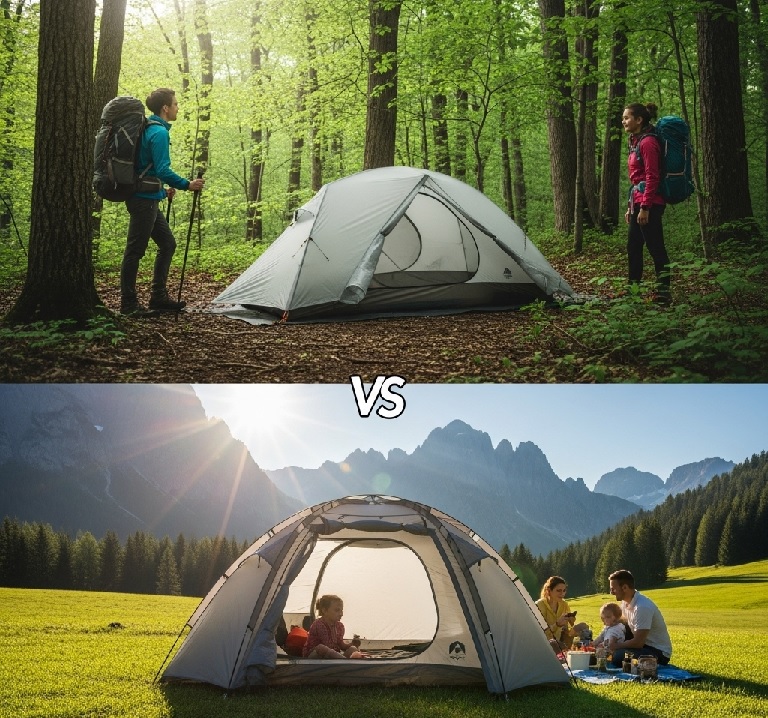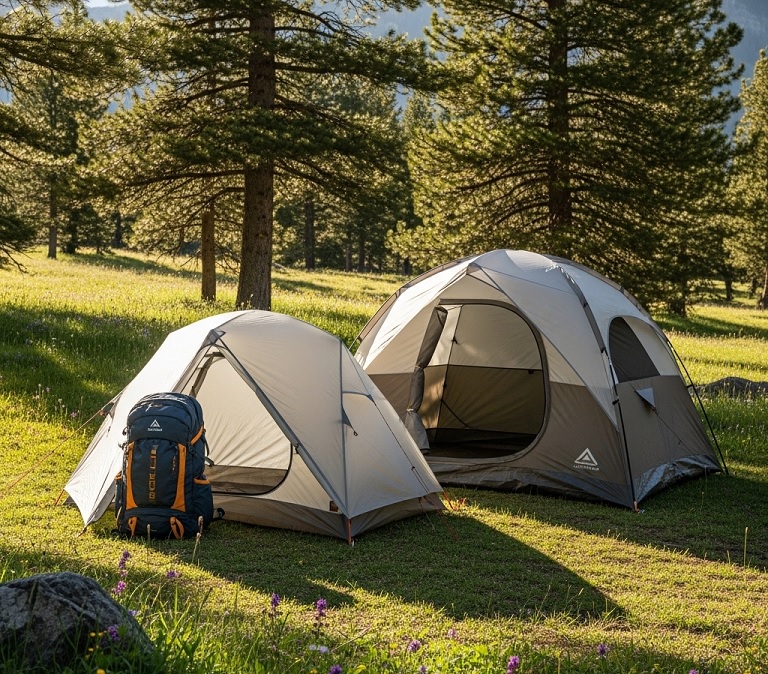This blog post may contain affiliate links. As an Amazon Associate I earn from qualifying purchases.
Choosing the right tent can make or break your outdoor adventure. Whether you’re setting out on a solo trek through the wilderness or planning a cozy weekend getaway with friends, the type of tent you choose matters.
You might be wondering: what’s the difference between a backpacking tent and a camping tent? More importantly, which one is right for you? Imagine waking up to the sound of chirping birds, enveloped in the crisp morning air, without the worry of a poorly chosen tent ruining your experience.
By understanding the distinct features and benefits of each option, you can ensure comfort and convenience on your next trip. You’ll discover how to match your tent choice to your adventure style, ensuring that your escape into nature is as enjoyable as you’ve always dreamed. Ready to uncover the secrets to a perfect camping experience? Read on to equip yourself with the knowledge you need to make the best decision for your outdoor escapades.
Backpacking Tents
Last update on 2025-09-30 / Affiliate links / Images from Amazon Product Advertising API
Backpacking tents are essential for those who love to explore nature on foot. Unlike camping tents, they are designed for lightweight and easy portability. These tents cater to hikers who need to carry their shelter with them. The focus is on reducing weight without compromising on essential features. Backpacking tents offer a balance of convenience, protection, and comfort. Let’s delve into their unique characteristics.
Weight And Portability
Backpacking tents are renowned for being lightweight and portable. These qualities make them ideal for long treks. The materials used are often lightweight yet durable. Most tents weigh between 2 to 5 pounds, making them easy to carry. Here are some key points:
- Lightweight Tents: Designed to be carried in a backpack.
- Compact Design: Packs down small for easy transport.
- Portable Shelters: Provides necessary protection without bulk.
The table below showcases typical weights for different backpacking tent types:
| Tent Type | Average Weight |
|---|---|
| Solo Backpacking Tent | 2-3 pounds |
| Two-Person Tent | 3-4 pounds |
| Three-Person Tent | 4-5 pounds |
Setup And Packability
Tent Setup is crucial for backpacking tents, emphasizing quick assembly. Backpackers often set up camp in varying conditions, so ease of setup is vital. Most tents utilize simple pole systems or clips. Key features include:
- Quick Setup: Enables fast assembly and disassembly.
- Compact Packability: Fits neatly into hiking equipment.
- Efficient Design: Optimized for easy use.
Backpacking tents usually come with instructions that make setup intuitive, even for beginners. Their design allows campers to focus more on the adventure and less on the logistics of setting up camp.
Durability And Weather Resistance
While lightweight, backpacking tents are weatherproof tents designed to withstand the elements. They offer protection against wind, rain, and other weather conditions. Important aspects include:
- Durable Materials: Made with rip-stop fabrics.
- Weather Resistance: High-quality seams and waterproof coatings.
- Stability: Designed to hold up in strong winds.
Backpacking tents often include features like reinforced corners and robust zippers. Their construction provides peace of mind for outdoor enthusiasts facing unpredictable weather.
Also Read: Tent Vs Teepee: Which Shelter Suits Your Adventure?
Space And Comfort
Backpacking tents prioritize tent space while maintaining comfort. Though compact, they offer enough room for sleeping and storing camping gear. Considerations include:
- Interior Space: Efficient use for sleeping and gear.
- Outdoor Comfort: Balances space with portability.
- Vestibules: Additional storage areas for gear.
These tents often feature clever designs like dual doors or gear lofts to maximize usability. They aim to provide a cozy refuge after a long day of hiking.
Price Range
Backpacking tents vary widely in cost, from budget tents to high-end models. The price often reflects material quality and additional features. Here’s what to expect:
- Affordable Options: $100 to $200, suitable for beginners.
- Mid-Range: $200 to $400, balancing quality and price.
- Premium Models: $400+, offering advanced features.
Investing in a backpacking tent depends on frequency of use and specific needs. Evaluating options based on hiking equipment requirements helps ensure the best choice for your adventures.

Camping Tents
Last update on 2025-09-30 / Affiliate links / Images from Amazon Product Advertising API
When planning an adventure in the great outdoors, choosing the right tent can make all the difference. Backpacking tents and camping tents each have their unique advantages. Understanding these can enhance your outdoor experience. Camping tents are designed with comfort in mind, ideal for those who prioritize space and amenities over portability. Let’s delve into the various aspects of camping tents to see how they can be the perfect outdoor shelter for your needs.
Size And Capacity
Camping tents are generally more spacious than their backpacking counterparts. They are built to accommodate more people and gear, making them ideal for family outings or group trips. Here are some key points about their size and capacity:
- Tent Capacity: Often ranges from 4 to 10 people.
- Interior Space: Provides room for standing and moving around.
- Storage: Extra space for storing camping equipment and personal items.
A table can highlight some typical dimensions:
| Tent Type | Capacity | Dimensions |
|---|---|---|
| 4-Person Tent | 4 people | 9 x 7 feet |
| 6-Person Tent | 6 people | 10 x 9 feet |
Ease Of Setup
Setting up a camping tent might seem daunting, but modern designs have simplified the process. Setup time varies, but many tents are designed for easy assembly. Consider these factors:
- Color-coded poles: Helps in quick identification and assembly.
- Freestanding designs: Allows for movement before securing.
- Instant tents: Pop-up mechanisms reduce setup time significantly.
These features ensure that even beginners can manage the setup without much trouble, making your camping trip planning smoother.
Features And Amenities
Camping tents come loaded with features that enhance comfort and convenience. Here are some common amenities:
- Multiple Doors: Facilitate easy access without disturbing others.
- Mesh Windows: Improve ventilation while keeping bugs out.
- Built-in Pockets: Handy for storing small items like flashlights or phones.
- Rainfly: Provides extra protection against weather elements.
These tent features make camping tents a home away from home, ensuring a comfortable stay in the wilderness.
Cost Considerations
Budget camping is possible with camping tents, as they vary widely in price. Factors affecting cost include:
- Size and Capacity: Larger tents with more space are generally more expensive.
- Material Quality: Durable materials like ripstop nylon or polyester add to the cost.
- Extra Features: Additional features like vestibules or advanced ventilation systems increase price.
For those seeking value, it’s wise to balance between hiking essentials and luxury.
Best Use Cases
Camping tents shine in scenarios where comfort and space are priorities. Some ideal use cases include:
- Family Camping Trips: Ample space for families to sleep and play.
- Group Outings: Accommodates friends or groups with ease.
- Long-term Camping: Perfect for extended stays at a single site.
For those who prefer a lightweight tent or are focused on backpacking gear, a backpacking tent might be more suitable. But for those prioritizing comfort, camping tents are unmatched.
Read More: Bivy Vs Tent: Choose the Ultimate Adventure Shelter
Key Differences
Choosing between a backpacking tent and a camping tent involves understanding their key differences. Both tent types serve distinct purposes and cater to various outdoor adventures. Whether it’s lightweight tents for hiking essentials or spacious camping equipment for family trips, knowing these differences helps make an informed decision. Dive into the weight, material, intended use, and user experience to find the perfect portable shelter for your travels.
Weight Comparison
Weight plays a crucial role in selecting the right tent for your outdoor adventures. Backpacking tents are designed with lightweight materials to minimize the load on your back. They typically weigh between 2 to 5 pounds, making them ideal for long hikes and backpacking gear. In contrast, camping tents are heavier, ranging from 5 to 15 pounds. This added weight offers more space and comfort but can be cumbersome for long-distance travel.
- Backpacking Tents: 2-5 pounds
- Camping Tents: 5-15 pounds
Consider a table for weight comparison:
| Tent Type | Average Weight (lbs) |
|---|---|
| Backpacking Tent | 2-5 |
| Camping Tent | 5-15 |
For hiking essentials, choose lightweight tents to ease the journey. For camping comfort, opt for heavier camping tents.
Material And Construction
Material and construction influence tent durability and weather resistance. Backpacking tents use high-tech fabrics like nylon or polyester, providing a balance of strength and lightness. These travel tents often feature aluminum poles, enhancing their portability.
- Nylon or Polyester: Used in backpacking tents for lightweight and strength.
- Aluminum Poles: Offers durability and reduces weight.
Camping tents prioritize sturdiness and space. They are often made with canvas or heavier polyester, supporting larger frames. Steel poles add to their robustness, making them suitable for extended stays.
- Canvas or Heavy Polyester: Common in camping tents for durability.
- Steel Poles: Provides strong support for larger tents.
Understanding the materials ensures your tent withstands various weather conditions during outdoor adventures.
Intended Use
The intended use guides the choice between tent types. Backpacking tents cater to hikers seeking compact and portable shelters. Their design ensures easy packing and quick setup, essential for spontaneous trips. These tents are hiking essentials for solo adventurers and small groups.
- Solo Adventures: Ideal for one-person trips.
- Small Groups: Suits two to three people.
Camping tents focus on camping comfort for families or groups. They offer ample space, allowing for sleeping, storage, and relaxation. These tents are camping equipment essentials for family vacations or car camping.
- Family Vacations: Accommodates larger groups.
- Car Camping: Provides spacious living areas.
Selecting the right tent ensures a comfortable and enjoyable outdoor experience.
User Experience
User experience varies greatly between tent types. Backpacking tents prioritize ease of use and quick assembly. Their simple design allows for efficient setup, crucial during unpredictable weather. Lightweight tents improve mobility and enhance the backpacking experience.
- Quick Assembly: Easy to set up in various conditions.
- Enhanced Mobility: Lightweight design improves travel speed.
Camping tents offer a different user experience, focusing on space and comfort. Their larger size provides ample room for sleeping and storage, creating a home-like feel. While setup might take longer, the spacious interiors make it worthwhile.
- Spacious Interiors: Offers ample room for activities.
- Comfortable Living Space: Creates a homely environment.
Choose the tent that aligns with your travel needs and enhances your outdoor adventure.
Choosing The Right Tent
Choosing the right tent is an essential decision for any outdoor adventure. Whether you’re embarking on a backpacking trip or a more leisurely camping excursion, the tent you select can greatly impact your experience. Understanding the differences between a backpacking tent and a camping tent is key. Both types offer unique benefits, and the best choice depends on your specific needs and circumstances. Consider factors such as trip duration, terrain, budget, and personal preferences to ensure you have the best shelter for your journey.
Trip Duration
The length of your trip significantly influences the type of tent you should choose. For short trips, a lightweight tent is often sufficient, especially if you’re on the move frequently. These tents are easy to pack and quick to set up, making them ideal for hikes lasting a couple of days. A backpacking tent is typically designed for such needs, prioritizing portability and ease of use.
- 1-2 days: Opt for a small, lightweight tent.
- 3-5 days: Consider a tent with more features and comfort.
- Week-long: A durable tent with ample space may be necessary.
For extended camping trips, consider a tent that offers more comfort and space. A camping tent is generally heavier but provides more room, better ventilation, and weather resistance. This type of tent is perfect for when you’re setting up base at a single location for several days.
Terrain Considerations
The terrain you will encounter is another vital factor. If your adventure leads you through rough, rocky landscapes, a backpacking tent with a sturdy frame and durable materials is a must. These tents are designed to withstand challenging environments, offering both protection and lightweight portability.
Consider the following when evaluating terrain:
| Type of Terrain | Recommended Tent |
|---|---|
| Mountainous | Backpacking Tent with strong stakes |
| Forest | Camping Tent with ample ventilation |
| Desert | Tent with UV protection and sand anchors |
In contrast, if your outdoor adventure is in a more controlled environment like a campsite, a camping tent with additional comforts can enhance your experience. These tents are typically larger and offer features such as multiple rooms and enhanced tent capacity.
Budget Constraints
Your budget will inevitably play a role in your decision. Backpacking tents often come at a higher price point due to their advanced materials and design for hiking equipment. Investing in a quality tent is wise if your adventures frequently take you into the backcountry.
For those with tight budgets, consider these options:
- Check for end-of-season sales to find discounts on quality tents.
- Consider renting a tent for infrequent trips.
- Look for used tents in good condition from reputable sellers.
A camping tent may be more budget-friendly, offering good value for those who enjoy occasional camping trips. Despite being less expensive, these tents can still provide essential features like weather resistance and comfort.
Personal Preferences
Your personal preferences are just as important. Some prefer the compact and efficient design of a backpacking tent, which allows for easy movement and quick setup. These tents are part of essential backpacking gear for those who value lightweight and portable equipment.
- Do you prioritize comfort over portability?
- Is ease of setup more important than additional features?
For those who enjoy more leisurely trips, a camping tent may be preferable. With more space and extra tent features, these tents provide a comfortable home away from home. They are ideal if you value space and are not concerned about carrying weight.
Ultimately, your choice will depend on your unique needs and the specific camping essentials you prioritize. Whether it’s a compact tent for a solo hike or a spacious tent for a family outing, the right tent can make all the difference in your outdoor experience.
Popular Brands
Choosing between a backpacking tent and a camping tent can be challenging. Each serves a unique purpose. Backpacking tents are designed for hikers needing lightweight shelters. Camping tents are ideal for families or groups, offering more space and comfort. Understanding popular brands helps narrow down choices for your outdoor adventures. Brands specialize in different tent features, ensuring you find the right fit for your needs.
Top Backpacking Brands
When it comes to backpacking, brands focus on lightweight tents and portability. Some leading names include:
- MSR (Mountain Safety Research): Known for their durable and lightweight tents. Ideal for long hikes and challenging weather conditions.
- Big Agnes: Offers compact designs perfect for backpacking gear. Their tents are easy to set up and pack down.
- REI Co-op: Popular for affordable and reliable hiking shelters. They provide good value for money.
Below is a table comparing some key features:
| Brand | Tent Weight | Durability | Price Range |
|---|---|---|---|
| MSR | 2-3 lbs | High | $300-$600 |
| Big Agnes | 2-3 lbs | Medium | $250-$500 |
| REI Co-op | 3-4 lbs | Medium | $150-$300 |
Leading Camping Tent Brands
For camping tents, brands focus on space and comfort. Here are some top picks:
- Kelty: Offers spacious tents suitable for family camping. Known for their sturdy designs and easy setup.
- Coleman: A household name in camping essentials. Their tents are affordable and widely available.
- North Face: Provides high-quality tents with advanced features. Ideal for those seeking robust outdoor equipment.
Consider these factors when choosing a camping tent:
- Space: Ensure the tent offers enough room for occupants and gear.
- Setup: Check if the tent is easy to assemble.
- Weather Resistance: Look for tents that can withstand various conditions.
Brand Comparisons
Comparing these brands involves assessing tent weight, durability, and price. Backpacking tents are generally lighter due to their compact design. Camping tents offer more space, making them heavier but more comfortable.
Consider tent durability. Backpacking tents from MSR and Big Agnes are designed to withstand harsh conditions. Camping tents from Kelty and North Face offer robust structures, perfect for extended stays.
Price is another factor. Backpacking tents tend to be pricier due to specialized materials. Camping tents vary widely, with budget-friendly options from Coleman.
Decide based on your priority: lightweight for backpacking or comfort for camping. Both offer unique benefits, ensuring enjoyable outdoor adventures.
Maintenance And Care
Taking care of your backpacking and camping tents is crucial for their longevity and performance. Proper maintenance and care ensure your portable shelters are ready for every adventure. Whether you’re dealing with lightweight tents for backpacking or more durable tents for camping, following the right steps in cleaning, storing, and repairing can make a significant difference. This section will guide you through essential maintenance tips for your outdoor equipment.
Cleaning Tips
Regular cleaning of your tent is essential to maintain its condition and functionality. Dirt and debris can weaken the fabric over time. For lightweight tents, which are often more delicate, gentle cleaning methods are best. Here’s a simple guide:
- Spot Cleaning: Use a soft sponge and mild soap to clean dirty spots. Avoid harsh chemicals.
- Full Wash: Fill a bathtub with lukewarm water and mild soap. Gently scrub the tent.
- Rinse Thoroughly: Ensure all soap is washed off to prevent residue buildup.
- Dry Completely: Air-dry the tent out of direct sunlight to avoid UV damage.
For larger camping tents, you might need more space. A garden hose can be helpful to rinse off excess dirt. Here’s a quick table for cleaning methods:
| Tent Type | Cleaning Method |
|---|---|
| Lightweight Tents | Spot cleaning, gentle hand wash |
| Camping Tents | Hose rinse, gentle scrub |
Storage Recommendations
Proper storage is a key part of tent maintenance. Incorrect storage can lead to mold, mildew, and fabric degradation. Here are some tent storage tips:
- Dry Before Storing: Always ensure the tent is completely dry to prevent mold growth.
- Use a Loose Bag: Store the tent in a breathable bag, not its compression sack. This helps maintain its fabric.
- Keep in a Cool, Dry Place: Avoid humid environments that can encourage mold and mildew.
- Avoid Direct Sunlight: Prolonged exposure can weaken the fabric of your camping gear.
For backpacking gear, consider hanging the tent in a closet or laying it flat under a bed. This avoids creases that can damage the fabric over time.
Repairing Damage
Damages are inevitable with frequent use of outdoor equipment. Quick and efficient tent repair can extend your tent’s life. Follow these steps for common issues:
- Small Tears: Use a patch kit designed for tents. Clean the area, apply adhesive, and press the patch firmly.
- Broken Poles: Repair kits often include splints. Slide the splint over the broken section and secure it tightly with duct tape.
- Seam Leaks: Apply seam sealer to the inside of the tent seams. Let it dry completely before packing.
For durable tents, a professional repair service can be a good option for extensive damage. Keep a repair kit as part of your camping essentials to handle issues promptly while on a trip.
Frequently Asked Questions
What Is The Difference Between Backpacking Tents And Camping Tents?
Backpacking tents are lightweight and compact, designed for portability. Camping tents are more spacious and heavier, prioritizing comfort over portability. Backpacking tents suit hikers needing easy transport, while camping tents offer more room for families or groups staying at campsites.
Choose based on mobility needs and group size.
Can You Use A Backpacking Tent For Camping?
Yes, you can use a backpacking tent for camping. It’s lightweight, portable, and easy to set up. Ideal for hikers and campers who prioritize mobility. Ensure it meets your camping needs regarding size and weather protection. Always check the tent’s specifications for suitable conditions.
What Makes A Tent A Backpacking Tent?
A backpacking tent is lightweight and compact, designed for easy transport. It offers quick setup and durability. Typically, it accommodates one to three people and provides weather protection. These tents focus on space efficiency and weight reduction, making them ideal for hikers and backpackers seeking convenience and portability.
What’s The Difference Between Camping And Backpacking?
Camping involves staying at a designated site with amenities like tents or RVs. Backpacking requires carrying gear and hiking to remote locations. Camping offers comfort and convenience, while backpacking emphasizes self-sufficiency and adventure. Both provide outdoor experiences, but differ in accessibility and gear requirements.
Conclusion
Choosing between a backpacking and camping tent depends on your needs. Backpacking tents are lightweight. Perfect for hikes and treks. Camping tents offer more space. Great for family trips or group outings. Consider your adventure type. A solo hike or a family camping trip?
Each tent has its perks. Know your priorities. Comfort or portability? The right tent enhances your outdoor experience. Make an informed choice. Enjoy nature with ease. Happy camping!












